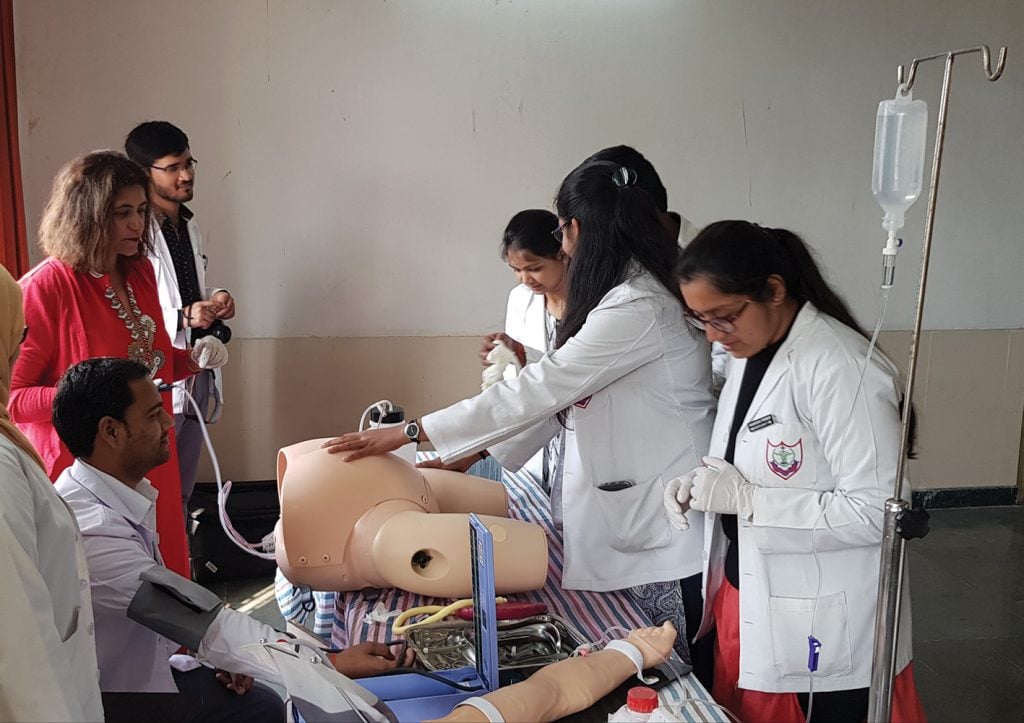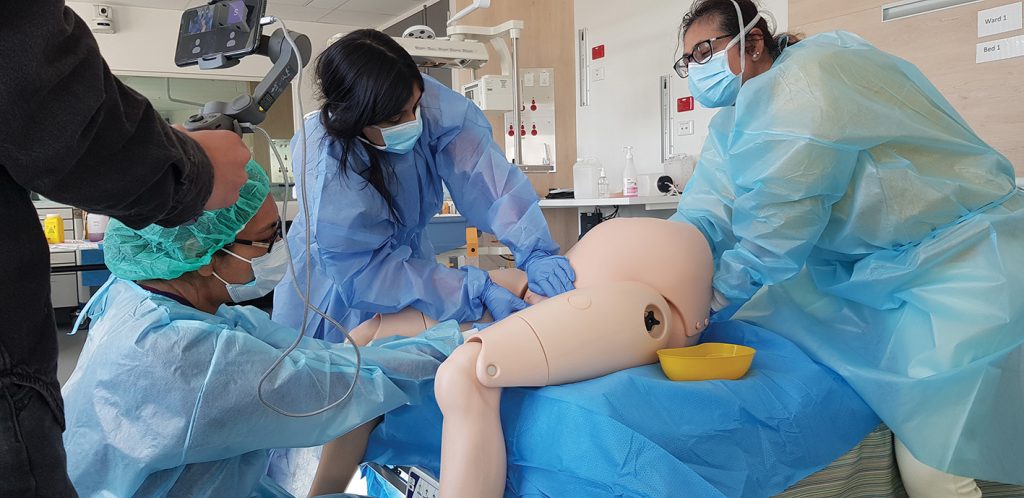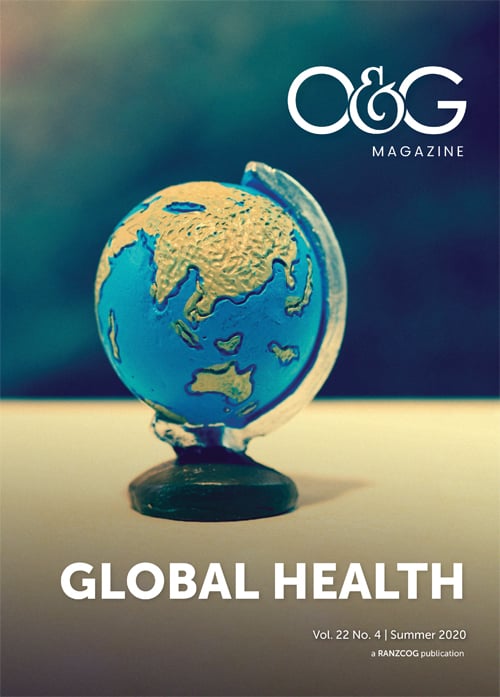The unmet need
Maternal and neonatal mortality continues to place a substantial burden on resources in low- and middle-income countries. Most maternal deaths worldwide occur in low-resource settings, and many are due to preventable causes such as postpartum haemorrhage, infection and pre-eclampsia. On the other hand, common causes of global neonatal deaths include perinatal asphyxia, prematurity, low birth weight and sepsis. Perinatal asphyxia itself accounts for close to one million neonatal deaths around the world every year. Despite decline in recent years, maternal and neonatal mortality rates, particularly in India and parts of Africa, continue to remain high.
There are a number of factors that contribute to maternal and neonatal outcomes. One of the key factors is training of obstetric and midwifery teams, and students in independent silos.1 An approach to maternity team-based interprofessional learning (in students and clinicians) has been shown to improve relationships between teams,2 which contributes to improved clinical care. A significant factor which influences mortality rates is the lack of training provided to healthcare workers in poorly resourced and remote settings, where transfer to larger referral centres may be challenging. Compared to high-income countries, low–middle-income countries (LMICs) also experience a shortage of doctors and nurses in relation to their population. Public health institutions range from specialised urban hospitals to rural primary health centres in these countries, but some households still visit unqualified private providers for healthcare. Even amongst those with qualifications, the support from experienced medical professionals can be low in rural and remote settings. Medical and nursing educational institutions in small towns, centres in LMICs may have scant facilities, expertise and opportunities for clinical exposure during training, as well as a lack of continuing education, skill maintenance and collaborative team culture, which have been implicated as barriers to providing adequate healthcare.
The educational program
In an attempt to address the education gap that exists for childbirth emergencies in LMICs, obstetrician, Dr Arunaz Kumar and neonatologist, Dr Atul Malhotra developed an education package, ONE-Sim. Dr Kumar is an educational researcher and has a PhD in simulation-based interprofessional obstetric education, while Dr Malhotra is a clinician scientist and educator. The Obstetric and Neonatal Emergency Simulation (ONE-Sim) interprofessional workshops are now a part of medical, nursing and midwifery undergraduate and postgraduate education at Monash University, Melbourne, Australia, and a number of centres in LMICs (onesimeducation.com). The workshops focus on common obstetric emergencies including obstructed labour, fetal distress, shoulder dystocia, neonatal resuscitation, and postpartum haemorrhage. ONE-Sim provides local healthcare professionals – obstetric and paediatric doctors, nurses, midwives, and students, education about dealing with complex childbirth and newborn care issues, through hands-on experience using simple simulation technology and team-based scenario design. Through a ‘Train the Trainer’ workshop design, the ONE-Sim program also aims to empower local healthcare staff who can then further impart the training within their own workplace in a flexible way that suits the birth setting.
The ONE-Sim workshops use low technology, low-maintenance mobile equipment that can be packed in a suitcase. It can be transferred across locations and made accessible to distant sites, with a quick set up to implement obstetric and neonatal training for multi-professional teams. These include medical and midwifery staff and students, and other healthcare workers involved as birth attendants. Participants are afforded hands-on experience of managing birth emergencies using simulators, with focus on scenarios relevant to their individual setting, improving communication and teamwork skills in addition to addressing technical and problem-solving proficiency.3
Equipment
A Prompt Flex simulator (Limbs and Things, Bristol, UK) and neonatal resuscitation baby (Laerdal Medical, Stavanger, Norway) are used as simulation equipment. These are packed together in a suitcase and are easily portable from site to site, requiring 15–30 minutes to set up prior to the workshop.
Workshop
The ONE-Sim workshop is a 4–4.5-hour training session conducted at each site by the lead facilitators in conjunction with local medical facilitators. The design and content of workshops is developed based on an iterative convergent design, using feedback from the clinical site leads regarding each site’s available facilities, scope of practice and local protocols to direct clinical management. The ONE-Sim faculty would spend some time prior to the workshop understanding the work-based arrangements, facilities for birth attendants and referral process involved for each site. They would also interact with both the junior and senior medical-midwifery staff regarding the roles of birth attendants and back-up arrangements available in case of an emergency. This background work assists in developing rapport with the local senior clinicians who co-design the scenarios and co-facilitate the teaching and debrief sessions.
On the day of the workshop, at the start of the session, the simulation is conducted for the senior medical and midwifery clinicians who later co-facilitate the session with the ONE-Sim faculty. The objective of co-facilitation is to engage learners better, by providing direct translation of the teaching through senior medical-midwifery staff in the local language, and to develop a home-based interprofessional medical-midwifery faculty for conducting future in-house training workshops.

Figure 1. ONE-Sim scenario in action in an Indian hospital.
Following demonstration of birth on the simulators and familiarisation with the equipment, participants undergo independent skills training with stations on conducting normal labour, recognising and managing obstructed labour, breech birth, shoulder dystocia and postpartum haemorrhage, and resuscitation of an asphyxiated newborn, with feedback provided at each skill station. The initial experience of conducting an uncomplicated vaginal birth helps in familiarisation with the simulation equipment and encourages immersion in the simulation scenarios that follow. Participants then practise management of obstetric and neonatal emergencies on the simulators in teams during scenarios facilitated by the ONE-Sim faculty with the help of the trained senior medical-midwifery clinicians. The scenarios include a variety of team-based clinical situations, including some where conflict between teams is anticipated. This prompts discussions about management and the divisions of responsibility and is helpful in encouraging a team-based learning approach. Finally, participants contribute to a discussion of clinical and debrief, again conducted with the help of medical-midwifery clinicians who also provide translation in local language where needed, emphasising key learning messages from the workshop.

Figure 2. Online ONE-Sim scenario in action during the COVID-19 pandemic.
The research impact and vision
Over the last five years, the ONE-Sim program has continued to grow and expand. ONE-Sim workshops are now run for medical and midwifery staff4 and students in Melbourne5 and overseas.6 There are workshops being conducted in new centres, towns and cities across India every year. The impact of the ONE-Sim program has been extensively evaluated for sustained learning and translation to practice.7 Workshops are also run in a number of countries in the Asia-Pacific region and Africa (especially Malawi) by collaborators and organisations. COVID-19 interrupted international travel and the ONE-Sim global health education program, but after a brief hiatus, we were able to conduct the ONE-Sim program virtually through an online platform.8 There are workshops now run every month for Australian students and health professionals, and for centres around the world. Simulation in healthcare (possibly with added online components), provides us with limitless, flexible and widespread options for education and training, and will continue to be a vital component of effective healthcare.
The ONE-Sim team endeavours to extend the program globally through its flexible learning design. The workshop can be adapted for varied healthcare settings and participants ranging from undergraduate medical and midwifery students to obstetric, neonatal clinicians, midwifery practitioners and other healthcare workers providing maternity care. The ONE-Sim team continues its effort to recruit budding obstetricians, paediatricians and midwifery practitioners to further build and strengthen the team with a view to translate its vision into reality.
Acknowledgements
The rest of the ONE-Sim team – Dr Nisha Khot, Dr Pramod Pharande, Dr Jennifer Hocking, Avi Malhotra.
Funding support – Royal Australasian College of Physicians, Bill & Melinda Gates Foundation, Overseas Medical Graduates Association (Vic) and the medical fraternity in Melbourne.
Collaborators – ASHA Charity, Pangea Global Health Education and local collaborators in various countries.
References
- Kumar A, Sweet L. Obstetric and Midwifery Education: Context and Trends. In: Nestel D, Reedy G, McKenna L, Gough S. (eds) Clinical Education for the Health Professions. 2020, Springer, Singapore.
- Kumar A, Wallace EM, East C, et al. Interprofessional Simulation-Based Education for Medical and Midwifery Students: A Qualitative Study. Clin Simul Nurs. 2017;13(5):217-7.
- Kumar A, Singh T, Bansal U, et al. Mobile obstetric and neonatal simulation based skills training in India. Midwifery. 2019;72:14-22.
- Kumar A, Singh T, Bansal U, et al. Mobile obstetric and neonatal simulation based skills training in India. Midwifery. 2019;72:14-22.
- Prasad N, Fernando S, Willey S, et al. Online interprofessional simulation for undergraduate health professional students during the COVID-19 pandemic. J Interprof Care. 2020;34(5):706-10.
- Gorantla S, Bansal U, Singh JV, et al. Introduction of an undergraduate interprofessional simulation based skills training program in obstetrics and gynaecology in India. Adv Simul (Lond). 2019;18;4:6.
- Kumar A, Khot N, Bansal U, et al. Lessons learnt from an obstetric neonatal emergency simulation program in India. J Neo Nursing. 2020. https://doi.org/10.1016/j.jnn.2020.07.004.
- Prasad N, Fernando S, Willey S, et al. Online interprofessional simulation for undergraduate health professional students during the COVID-19 pandemic. J Interprof Care. 2020;34(5):706-10.







Leave a Reply